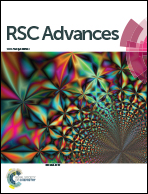An “off–on” fluorescent probe for the detection of cysteine /homocysteine and its imaging in living cells†
Abstract
Based on the NCL reaction, we report a novel “off–on” fluorescent probe BQ for the sensing of Cys/Hcy by a FRET strategy. Owing to the quenching effect of azo-based naphthalimide, BQ showed nonfluorescence. Upon the interaction of Cys/Hcy, a dramatic increase of the fluorescence signal was observed, with a high selectivity toward Cys/Hcy over GSH. Additionally, the discrimination of Cys from Hcy also could be achieved through the different rates of the transthioesterification reaction between thiols and BQ, especially when the concentration of Cys and Hcy was below 100 μM. The Cys/Hcy could be specifically labeled by the BODIPY fluorophore of BQ after the NCL reaction. Living cell imaging experiments demonstrated that BQ can selectively label Cys/Hcy and distinguish Cys/Hcy from other bioreagents including GSH in living systems.


 Please wait while we load your content...
Please wait while we load your content...